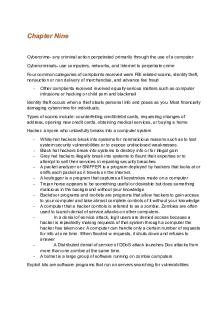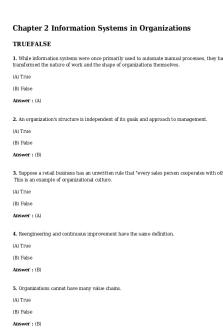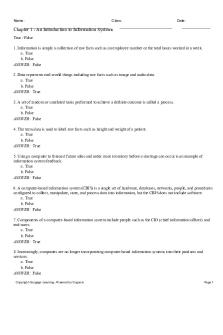Introduction to Computer Information Systems- Chapter 9 PDF

| Title | Introduction to Computer Information Systems- Chapter 9 |
|---|---|
| Author | Becca Klap |
| Course | Introduction to Computer Information Systems |
| Institution | Grand Rapids Community College |
| Pages | 4 |
| File Size | 58.5 KB |
| File Type | |
| Total Downloads | 11 |
| Total Views | 156 |
Summary
CIS/CO 100- Introduction to Computer Information Systems- MyLab Chapter Summaries
GRCC Pearson MyLab Technology in Action ...
Description
Chapter Nine Cybercrime- any criminal action perpetrated primarily through the use of a computer Cybercriminals- use computers, networks, and Internet to perpetrate crime Four common categories of complaints received were FBI related scams, identity theft, nonauction or non delivery of merchandise, and advance fee fraud -
Other complaints received involved equally serious matters such as computer intrusions or hacking or child porn and blackmail
Identity theft occurs when a thief steals personal info and poses as you. Most financially damaging cybercrime for individuals. Types of scams include: counterfeiting credit/debit cards, requesting changes of address, opening new credit cards, obtaining medical services, or buying a home Hacker- anyone who unlawfully breaks into a computer system -
-
White-hat hackers break into systems for nonmalicious reasons such as to test system security vulnerabilities or to expose undisclosed weaknesses. Black hat hackers break into systems to destroy info or for illegal gain Grey hat hackers illegally break into systems to flaunt their expertise or to attempt to sell their services in repairing security breaches A packet analyzer or SNIFFER is a program deployed by hackers that looks at or sniffs each packet as it travels on the Internet. A keylogger is a program that captures all keystrokes made on a computer Trojan horse appears to be something useful or desirable but does something malicious in the background without your knowledge Backdoor programs and rootkits are programs that allow hackers to gain access to your computer and take almost complete controls of it without your knowledge A computer that a hacker controls is referred to as a zombie. Zombies are often used to launch denial of service attacks on other computers. In a denial of service attack, legit users are denied access because a hacker is repeatedly making requests of that system through a computer the hacker has taken over. A computer can handle only a certain number of requests for info at one time. When flooded w requests, it shuts down and refuses to answer A Distributed denial of service of DDoS attack launches Dos attacks from more than one zombie at the same time. A botnet is a large group of software running on zombie computers
Exploit kits are software programs that run on servers searching for vulnerabilities
Logical ports are virtual, not physical, communication paths (email, ftp, http, telnet) Virus- program that attaches to a computer program to spread to others -
-
Main purpose is to replicate and copy its code into as many other host files as possible. Secondary objectives can be destructive Types include: boot sector (when computer boots up), logic bombs and time bombs (when certain conditions or dates are reached), worms (spread on own with no human interaction needed), script and macro (series of commands with malicious intent, could be attached to docs), email (spread as attachments to email, often using address books), encryption (hold files hostage by encrypting them and asking for ransom) Polymorphic virus changes its code to avoid detection. Most infect a particular type of file Multipartite is designed to infect multiple file types in an effort to fool the antivirus software that is looking for it. Stealth viruses temporarily erase their code from the files where they reside and hide in the active memory of the computer
Malware is software with malicious intent. -
Adware displays unsponsored ads and can track Spyware is an unwanted program that downloads with other software from the Internet and runs in the background Transmits info about you, use tracking cookies, and a keystroke logger program often monitors keystrokes Other anti-spyware programs are easy to install and update Data mining: gather personal info. Aggressive ads display enticing info to tempt you to buy.
Pop Up Blocking cannot be turned off in the Edge browser Windows Defender is included in windows, and defends against popups malware and hacking agents. Spam is unwanted or junk email. To help avoid spam: create a free email address, spam filters, buy third party programs, and reclassify emails that have been misidentified as spam Cookies are small text files that some websites automatically store on your hard drive when you visit them. -
Companies use this info to determine the traffic flowing through their website and the effectiveness of their marketing strategy. Do not search personal info. Main concern is that advertisers will use this info indiscriminately, thus invading your privacy. Cookies pose no security threat because it is virtually impossible ot hide a virus in a cookie
Social engineering is any technique using social skills to generate human interaction with the purpose of enticing individuals to reveal sensitive info. Pretexting involves creating a scenario that sounds legit. -
Phishing lures Internet users to reveal personal info. Pharming occurs when malicious code is planted on your computer. To avoid these schemes: Never reply directly to any email asking for personal info. Don’t click on email links, check with the company, use phishing filters, use internet security software that is updated.
Scareware is a type of malware that downloads onto your computer and tries to convince you that your computer is infect. You’re directed to a fake website to buy fake removal tools. Scareware is a social engineering technique because it uses people’s fear of computer viruses to convince them to part with their money. Firewall- software program or hardware device designed to protect computers from hackers. Both Windows and macOS invluce reliable firewalls. The Windows Action Center is a good source of info about the security settings on your computer including the firewall status. Norton Internet Security, McAfee, and ZoneAlarm incluce firewall software. -
Can be configured so they filter out packets sent to specific logical ports in a process known as packet filtering. Also can completely refuse requests from the Internet asking for access to specific ports in a process known as logical port blocking. Use a process called network address translation or NAT to assign internal IP addresses on a network. shieldUp at grc. Com to test
Symantec, Kaspersky, Trend Micro, and Avast have highly rated antivus software packages. -
A virus signature is a portion of the virus code that unique to a particular computer virus Quarantining involves placing a virus in a secure area so it won’t spread During inoculation, key attributes about your computer files are recorded and keep stats in secure place. Many viruses exploit weaknesses in OS. This type of attack, known as a drive-by download, affects almost 1 in 1000 web pages. Suites have other features like email scans, parental controls, and file shredding
Strong passwords- use Strong Password Generator or Password Meter to evaluate. Windows, macOS and most other OS have built-in password or passcode protection for files as well as the entire desktop.
Backing up data: copy personal data files to external hard drive, cloud services. Also, use system image to create a backup of your entire systems on an external
-
Biometric authentication device is a device that reads a unique personal characteristic such as a fingerprint or iris patterns and converts it to a digital code. High level of security. Also: voice authentication, facial recognition systems
Privacy tools connected with web browsers include: Private Browsing, InPrivate, Incognito. Portable privacy devices are Kingston Personal Flash Drives. VPNs are secure networks that are established using the public Internet infrastructure Backups are copies of files used to replace the originals if they’re lost or damages. Files to backup are data and program files. Types of backups include full, incremental, and image. Power surges occur when an electrical current is supplied in excess of normal voltage. Old or faulty wiring, downed power lines, malfunctions at electric company substations, and lightning can all cause this. -
A surge protector protects your computer. Replace every 2-3 years or after a major surge. All electronic devices that have solid- state components such as TVs, stereos, printers, and cell phones should be connected to a protector.
Three main security concerns with mobile devices: keep from being stolen, keep data secure in case they are stolen, finding a device if it is stolen. Windows Action Center: shows major events happening on your computer, provides quick access to security settings...
Similar Free PDFs

Chapter 9 Global Information Systems
- 65 Pages

INTRODUCTION TO COMPUTER HARDWARE
- 39 Pages
Popular Institutions
- Tinajero National High School - Annex
- Politeknik Caltex Riau
- Yokohama City University
- SGT University
- University of Al-Qadisiyah
- Divine Word College of Vigan
- Techniek College Rotterdam
- Universidade de Santiago
- Universiti Teknologi MARA Cawangan Johor Kampus Pasir Gudang
- Poltekkes Kemenkes Yogyakarta
- Baguio City National High School
- Colegio san marcos
- preparatoria uno
- Centro de Bachillerato Tecnológico Industrial y de Servicios No. 107
- Dalian Maritime University
- Quang Trung Secondary School
- Colegio Tecnológico en Informática
- Corporación Regional de Educación Superior
- Grupo CEDVA
- Dar Al Uloom University
- Centro de Estudios Preuniversitarios de la Universidad Nacional de Ingeniería
- 上智大学
- Aakash International School, Nuna Majara
- San Felipe Neri Catholic School
- Kang Chiao International School - New Taipei City
- Misamis Occidental National High School
- Institución Educativa Escuela Normal Juan Ladrilleros
- Kolehiyo ng Pantukan
- Batanes State College
- Instituto Continental
- Sekolah Menengah Kejuruan Kesehatan Kaltara (Tarakan)
- Colegio de La Inmaculada Concepcion - Cebu







![OBrien - Introduction to Information Systems [2010]](https://pdfedu.com/img/crop/172x258/zx28ke2j06rw.jpg)





